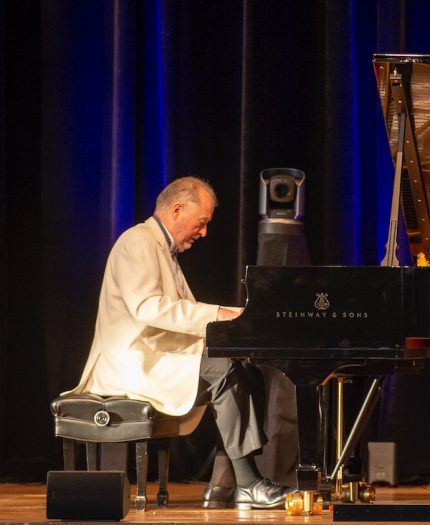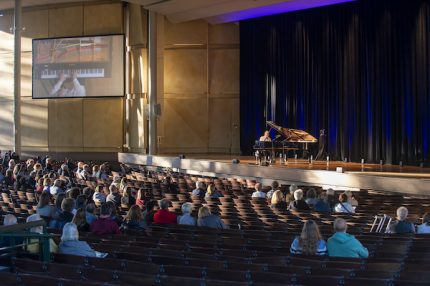Insight and virtuosity to the fore as Garrick Ohlsson reopens Ravinia with Brahms

However aggressively Ravinia may vie with other area venues as a summer showcase for high-powered pop music attractions, classical music in general, and the Chicago Symphony Orchestra in particular, remain at the core of what the festival is about, and has been about for 85 years.
Having skipped last summer because of the lockdown that shuttered the entire Ravinia Festival season, the CSO is scheduled to resume its annual residencies with a pair of concerts under Marin Alsop, serving her first season as chief conductor and curator, July 9-10.
It fell to the veteran American pianist Garrick Ohlsson to launch the festival season Thursday night with the first of four recitals devoted to solo piano works by Johannes Brahms—aptly so, for he is a familiar and respected figure to Ravinia audiences. Thursday’s concert marked his 23rd appearance at the festival, where he first appeared in 1981.
If this were a normal concert season, the pianist would have kicked off his Brahms cycle in the Martin Theatre, where Ravinia customarily presents its marquee-name recitals and small-ensemble events. But because the festival’s smaller auditoriums remain closed to the public, Ohlsson took his program to the foreshortened stage of the pavilion. According to available records, he is only the fourth pianist to present a solo recital there, having been preceded by John Browning (exactly 52 years before in 1969), Claudio Arrau (1970) and Emanuel Ax (1975).
Perhaps because of low temperatures and chilly winds a few hundred listeners took their seats in the 3,400-seat pavilion, thereby rendering social distancing a moot issue. The electronic closeups of Ohlsson in action, transmitted via screens at the sides of the amphitheater, helped to intensify musical communication across that yawning gulf of seats – as did, of course, his expert, deeply considered renditions of familiar and seldom-heard solo Brahms.
Ohlsson has long been celebrated for the burnished, firmly weighted sound he produces at the keyboard, and on Thursday he had enormous help in that regard from the instrument on which he performed. This recital marked the debut of a new, Hamburg-made Steinway grand he had auditioned and selected for Ravinia. Following pavilion performances this season, it will be moved to the Martin Theatre where it will replace the recently retired Steinway that, according to official records, resonated under the hands of more than 200 pianists over 28 festival seasons.
Brahms’ piano music has been central to Ohlsson’s repertory throughout his long career, and he has committed virtually all the solo piano works to disc. Three sets of variations dominated Thursday’s intermission-less program, with first Ravinia performances of the lesser-known Variations on an Original Theme and Variations on a Hungarian Song (Op. 21, Nos. 1 and 2, respectively) sharing the bill with the Eight Pieces of Op. 76, the three Intermezzos of Op. 117, and Book 1 of Variations on a Theme of Paganini, Op. 35.
One can think of few A-list virtuosos better equipped to vanquish not only the sometimes awkward technical difficulties of this music but also to lay bare its communicative possibilities. He understands that merely delivering a clean, efficient exposition of the notes Brahms put on the page is only half the battle, that the interpreter must search out the expressive meaning in and between the notes if this sometimes elusive music is to reveal its full essence. Above all, he never made piano writing that feels ungainly to the fingers sound ungainly to the ear.

Few listeners would claim that either set of Op. 21 variations represent Brahms at the absolute peak of his invention for the keyboard, yet such was Ohlsson’s evident belief in their innate musical value that he made absorbing discoveries of both pieces, which he played as a unit. Variations on an Original Theme is a longer and weightier work than the latter, and, by omitting all repeats, he made these highly contrasted works feel as if they naturally completed one another.
So it was with the character pieces—now elegiac and introspective, now dancing and graceful—of Op. 76 and 117. Ohlsson’s pianism was blessedly free of the bass-heavy ponderousness that has long passed for idiomatic Brahms in some quarters.
He brought winning articulation and variegated touch to the familiar B-Minor Capriccio, sonorous depth to the pensive lyricism of the well-known Intermezzo in E-flat, a discerning balance of emotion and intellect to the Intermezzo in B-flat minor. Best of all was the Capriccio in C-sharp minor, whose vigorous sweep was caught on the wing.
Basing his two books of Op. 35 variations on the famous 24th caprice from Paganini’s solo-violin caprices, Brahms gave pianists his most overtly exhibitionist keyboard work, along with the comparably inspired Handel Variations: None but the most formidably equipped virtuosos need apply. Ohlsson is among the favored few—his jaw-dropping virtuosity in the headlong variations was matched by the thoughtful deliberation of the slower ones. His word isn’t the final say on this masterpiece, of course, but on Thursday it felt pretty close to being definitive. Book 2 of Ohlsson’s traversal of the Paganinis will follow on July 7.
Brahms greatly admired Chopin’s music, so it made sense for Ohlsson to offer up a bit of Chopin as his encore—the ever-popular Waltz in C-sharp minor, (Op. 64, no. 2). His reading – each lilting phrase given its due color, shape and weight—sent one out into the chill night air with a satisfied smile.
Garrick Ohlsson’s cycle of Brahms solo piano works continues with recitals on July 5, 7 and 12 in the Ravinia pavilion. ravinia.org.
Posted in Performances




